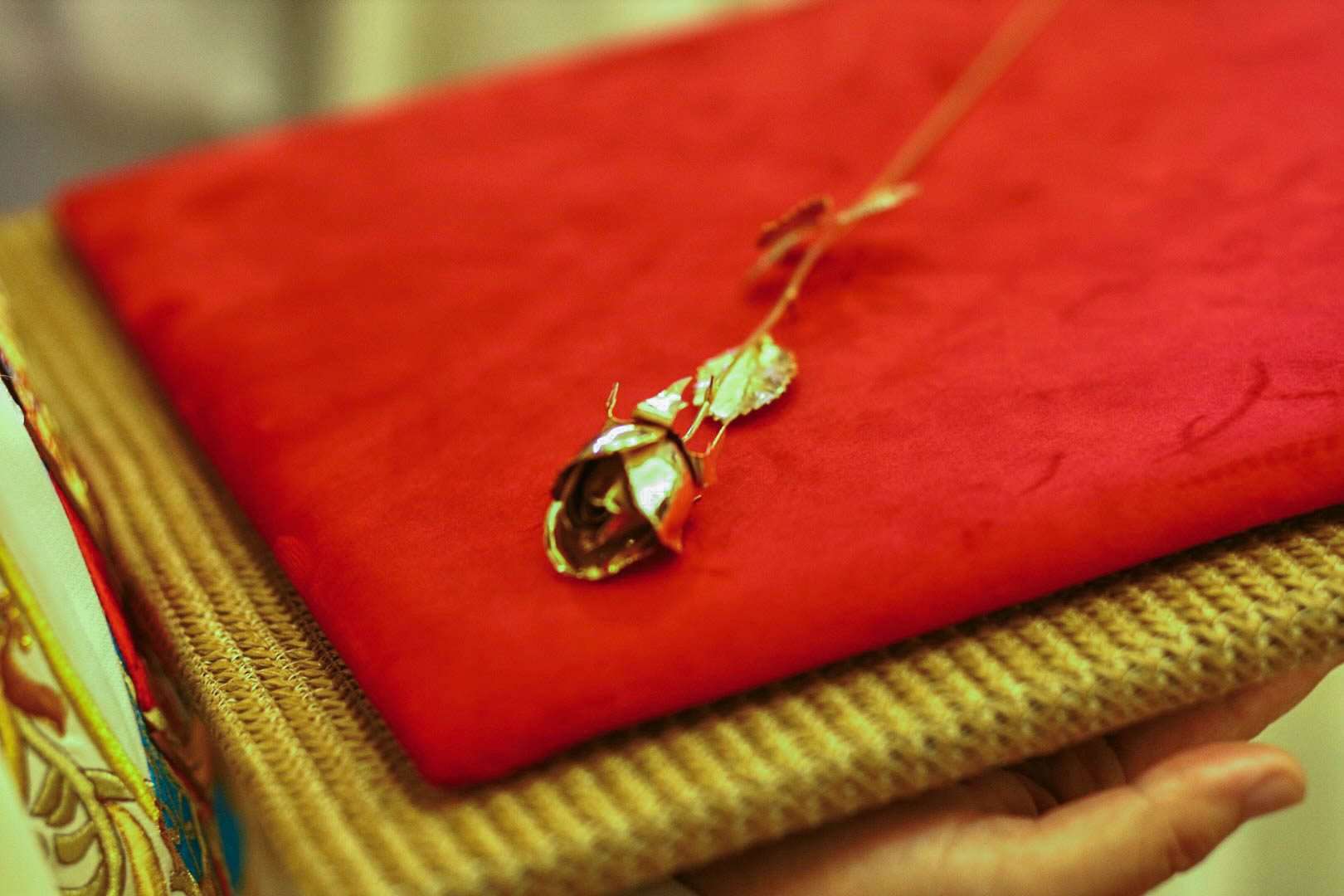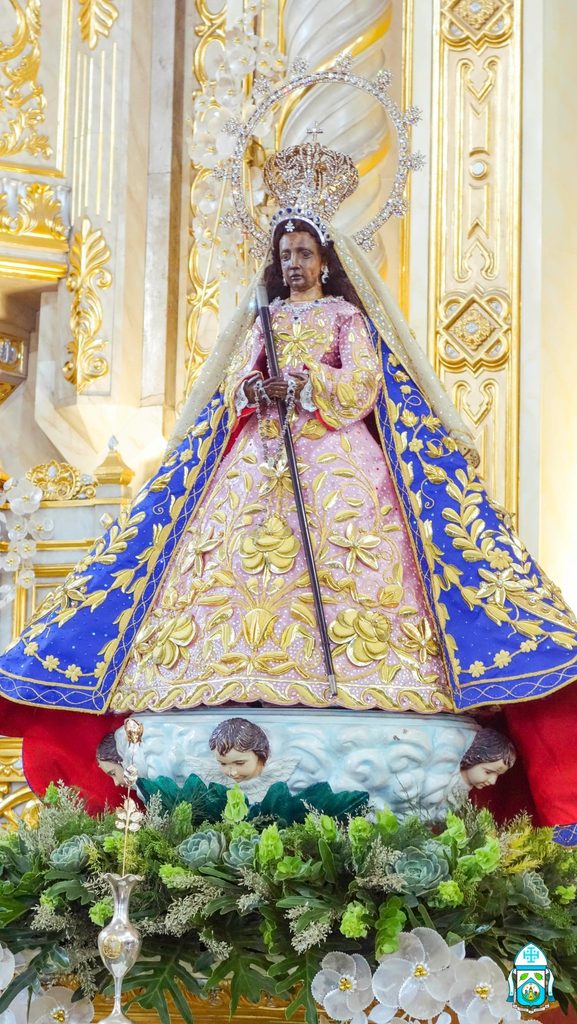SUMMARY
This is AI generated summarization, which may have errors. For context, always refer to the full article.

If this were a competition (and mind you, the holiest can also be the most competitive), the Diocese of Antipolo is on a winning streak.
Their latest source of pride (or, fine, “source of joy” since pride is a capital sin): a golden rose from Pope Francis.
Days before receiving this golden rose, the Diocese of Antipolo announced that one of its churches will soon receive another gift from the Pope: this time, a crown.
What’s with the crown and the golden rose?

The golden rose is the Pope’s way of honoring Our Lady of Peace and Good Voyage (Nuestra Señora de la Paz y Buen Viaje) – better known as the Virgin of Antipolo – after the 450-year-old Antipolo Cathedral became the Philippines’ first international Catholic shrine.
A golden rose “is considered the highest honor given personally by the Supreme Pontiff to a Marian image and shrine” anywhere in the world, said the Diocese of Antipolo, because it was commissioned by the Pope himself.
This papal custom of giving roses made of pure gold began before the year 1050, according to the Catholic encyclopedia New Advent. Since the Middle Ages, it was meant to be given to Catholic royalty, prominent individuals, and “governments or cities conspicuous for their Catholic spirit and loyalty to the Holy See, as a mark of esteem and personal affection.”

Golden roses are prepared in an elaborate ritual every fourth Sunday of Lent (Laetare Sunday, or “Rejoice Sunday”), when the Pope prays and blesses the roses on a candle-lit table. The Pope recites a prayer asking that God “bless and sanctify this rose, most delightful in odor and appearance, which we this day carry in sign of spiritual joy.”
Based on this prayer, the golden rose also symbolizes an appeal for God to “remit sin, strengthen faith, increase piety, protect her (the Church) in Thy mercy, drive away all things adverse to her, and make her ways safe and prosperous.”
The Pope then incenses balsam, which is an aromatic substance from plants, and then musk, which is a substance from a male musk deer that helps fragrance last longer. According to New Advent, he then “puts the balsam and powdered musk into the tiny cup in the heart of the principal rose,” after which he incenses the rest of the roses and sprinkles them with holy water.
The golden roses are then kept in the sacristy, where the priest changes vestments before and after Mass, until the Pope is about to give them away.
In the case of the Diocese of Antipolo, the local church said it “is the first time that a Marian shrine in the Philippines and on the whole continent of Asia has been given this honor.”
The golden rose was offered to the Virgin of Antipolo on Monday, February 26, by Archbishop Rino Fisichella, one of two pro-prefects of the Vatican’s Dicastery for Evangelization. (The other pro-prefect is Manila’s former archbishop, Cardinal Luis Antonio Tagle.)

Fisichella led the thanksgiving Mass for the declaration of the Antipolo Cathedral as an international shrine.
Another canonical coronation
Twelve days before this, on February 14, the Vatican informed the Diocese of Antipolo that it was also bestowing an honor – a canonical coronation – on an image of Mary in its diocese.
This is the image of Our Lady of Fatima de Marikina (Nuestra Señora de Fatima de Marikina) at the Diocesan Shrine and Parish Church of Saint Paul of the Cross in Marikina City.
Marikina, along with the whole province of Rizal, is part of the 2.9-million-strong Diocese of Antipolo.
A canonical coronation is a crowning of an image of the Virgin Mary in the name of the Pope. The Saint Paul of the Cross Parish said this “is the highest honor given by the Catholic Church to an image of the Blessed Virgin Mary.” (Note how the golden rose is said to be the “highest honor,” too, but “given personally” by the Pope.)
The canonical coronation of Nuestra Señora de Fatima de Marikina will take place on May 12, the eve of the Feast of Our Lady of Fatima.
In his message, Antipolo Bishop Ruperto Santos thanked the Pope “for this enormous and symbolic gift, which will surely deepen our devotion to the Mother of Our Lord Jesus, who is also our mother.”
This is the sixth image in the Diocese of Antipolo that will be canonically crowned, according to the news service of the Catholic Bishops’ Conference of the Philippines.
Here are the five others:
- Nuestra Señora dela Paz y Buenviaje from the International Shrine of Our Lady of Peace and Good Voyage in Antipolo
- Nuestra Señora de los Desamparados from the Diocesan Shrine of Our Lady of the Abandoned in Marikina
- Nuestra Señora de Aranzazu from the Diocesan Shrine – Parish of Nuestra Señora de Aranzazu in San Mateo
- Nuestra Señora de la Lumen from the Diocesan Shrine and Parish of Our Lady of Light in Cainta
- Nuestra Señora del Santísimo Rosario from the Diocesan Shrine of Our Lady of the Holy Rosary in Cardona
It looks like the Diocese of Antipolo – located in a mountainous, touristy province south of Manila – is closer to its goal of becoming the “spiritual pilgrimage capital of the Philippines.”
Six crowns and a golden rose, after all, are certainly rich in meaning, a great attraction for pilgrims seeking deeper peace.
How to turn these symbols into reality, or faith into action in this country mired in poverty, is another story. – Rappler.com
Add a comment
How does this make you feel?

![[The Wide Shot] Peace be with China](https://www.rappler.com/tachyon/2024/07/wideshot-wps-catholic-church.jpg?resize=257%2C257&crop=311px%2C0px%2C720px%2C720px)
![[OPINION] A critique of the CBCP pastoral statement on divorce](https://www.rappler.com/tachyon/2024/07/TL-cbcp-divorce-statement-july-19-2024.jpg?resize=257%2C257&crop=285px%2C0px%2C722px%2C720px)
![[REFLECTION] Mary, Mother of the West Philippine Sea](https://www.rappler.com/tachyon/2024/07/may-mother-west-ph-sea-july-19-2024.jpg?resize=257%2C257&crop=293px%2C0px%2C751px%2C750px)
![[OPINION] Ignorance and prejudice](https://www.rappler.com/tachyon/2024/07/tl-ignorance-and-prejujdice.jpg?resize=257%2C257&crop_strategy=attention)










There are no comments yet. Add your comment to start the conversation.